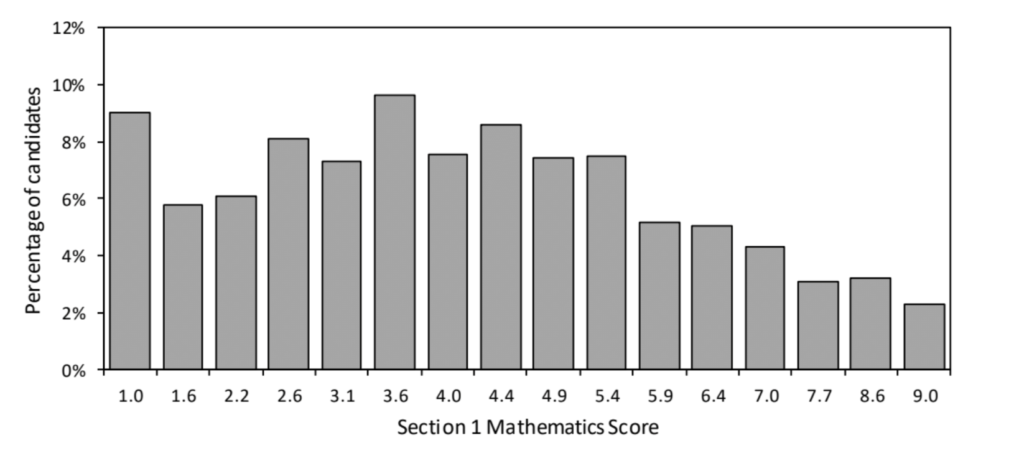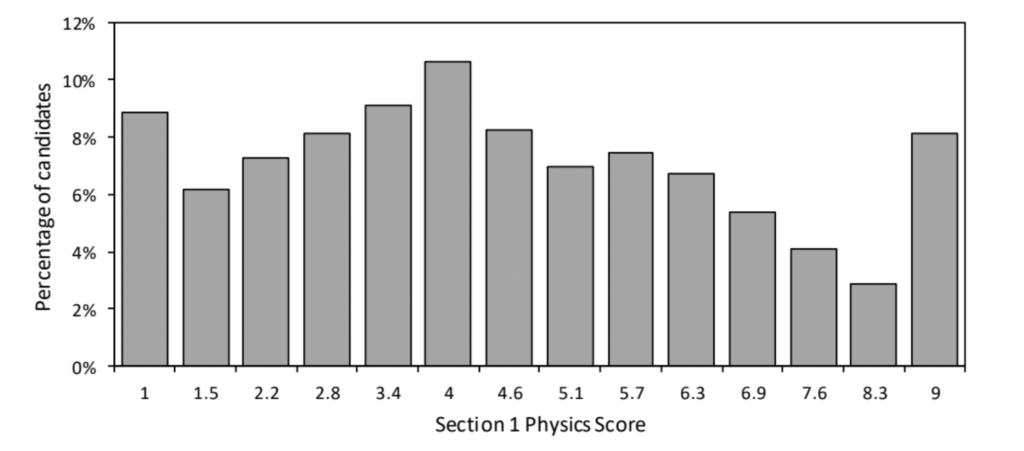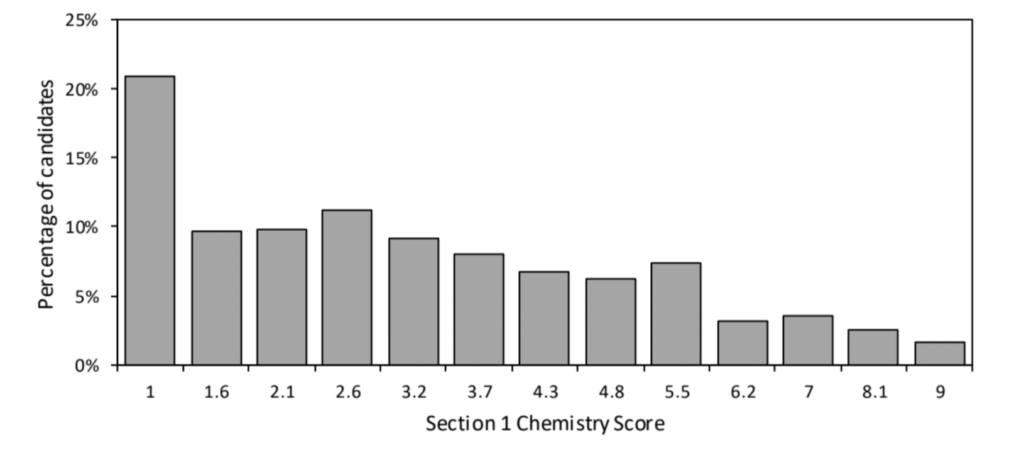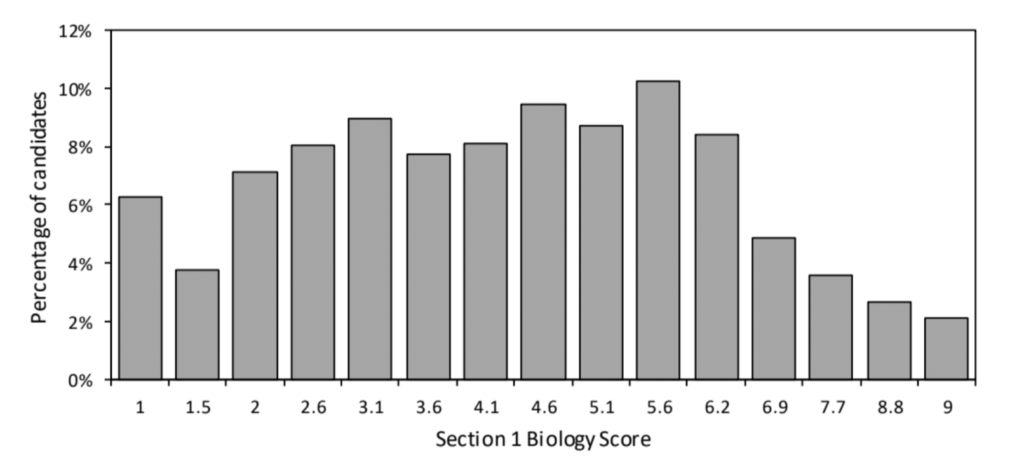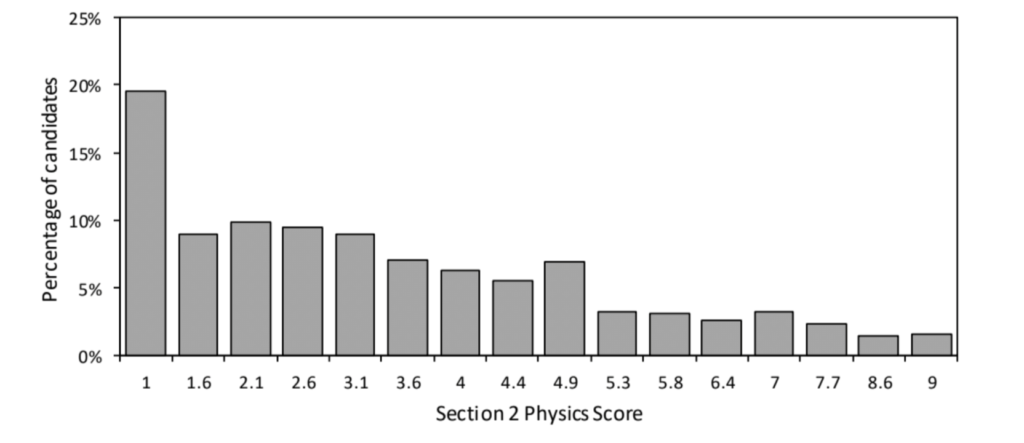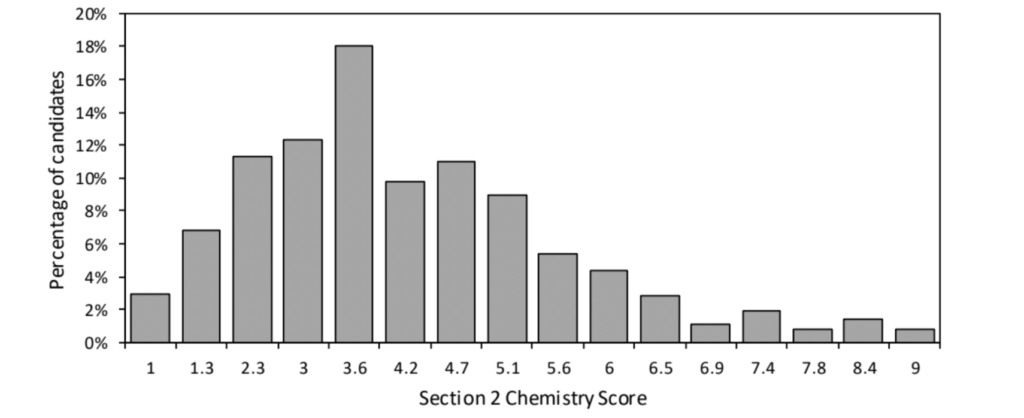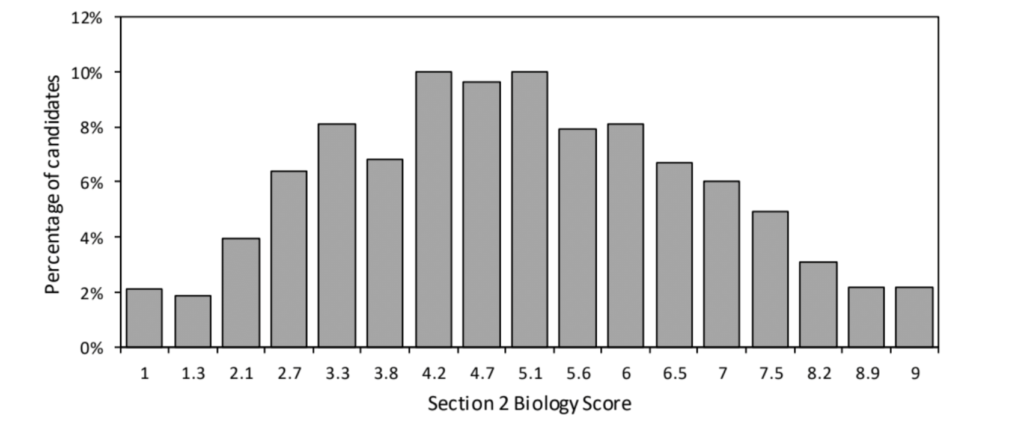YOUR ULTIMATE GUIDE
NSAA Results - The Definitive Guide to your NSAA Score
Written by: Matt Amalfitano-Stroud
Please be aware that, as of 2024, the Natural Sciences Admissions Assessment (NSAA) is no longer being used by the University of Cambridge. Cambridge applicants for Natural Sciences, Engineering, Veterinary Medicine and Chemical Engineering & Biotechnology will be required to sit the Engineering and Science Admissions Test (ESAT).
Whether you’ve already taken the assessment or are nervously awaiting the testing day, you’re most likely thinking about one thing; your NSAA Score. Getting a good score is the whole point of the exam so you’re going to want to have as much knowledge as possible about what you should be hoping to achieve. This guide will teach you everything you need to know about your NSAA results, including how the test is scored, what score you should be aiming for and results from previous year’s applicants.
1/4
HOW IS THE NSAA SCORED?
Before we delve deep into the context behind the NSAA results, let’s take a look at how the exam is actually scored and how the results are calculated.


As you should know by now, the Natural Sciences Admissions Assessment (NSAA) is split into a total of seven parts across two sections, of which each applicant must complete three. In Section 1, after the compulsory Part A (Mathematics), test-takers must choose between Parts B – D:
They must then choose one part to answer in Section 2:
Each of these parts contains the same amount of multiple-choice questions (20), each of which is worth one mark. The number of questions you get correct in each part will make up your raw mark, which is recorded separately for each part you answered. As with most admissions tests, there is no negative marking, so you don’t need to worry about losing makes for incorrect answers.
Your raw mark is only half the story, however, as the final result that is seen by Cambridge is your NSAA Score. This score is recorded on a scale between 1.0 (lowest) and 9.0 (highest). How is this calculated though?
Essentially, each year a conversion table is created using the research performed by Cambridge Assessments Admissions Testing (CAAT), which is based upon the difficulty of each part and previous years’ results. Each part of the exam will have a different conversion rate, meaning some parts will have higher conversions than others. (Be aware that this does not mean a part is noticeably easier or harder than another, the differences in conversions are very minor and won’t have a big impact on your score). Here you can check out the different 2021 conversion tables (for 2022 Entry) for each part.
NSAA Score Conversion Table 2022 Entry - Section 1
Part A - Maths
| Raw Mark | Converted Score |
|---|---|
| 0 | 1.0 |
| 1 | 1.0 |
| 2 | 1.0 |
| 3 | 1.0 |
| 4 | 1.0 |
| 5 | 1.6 |
| 6 | 2.2 |
| 7 | 2.6 |
| 8 | 3.1 |
| 9 | 3.6 |
| 10 | 4.0 |
| 11 | 4.4 |
| 12 | 4.9 |
| 13 | 5.4 |
| 14 | 5.9 |
| 15 | 6.4 |
| 16 | 7.0 |
| 17 | 7.7 |
| 18 | 8.6 |
| 19 | 9.0 |
| 20 | 9.0 |
Part B - Physics
| Raw Mark | Converted Score |
|---|---|
| 0 | 1.0 |
| 1 | 1.0 |
| 2 | 1.0 |
| 3 | 1.0 |
| 4 | 1.0 |
| 5 | 1.5 |
| 6 | 2.2 |
| 7 | 2.8 |
| 8 | 3.4 |
| 9 | 4.0 |
| 10 | 4.6 |
| 11 | 5.1 |
| 12 | 5.7 |
| 13 | 6.3 |
| 14 | 6.9 |
| 15 | 7.6 |
| 16 | 8.3 |
| 17 | 9.0 |
| 18 | 9.0 |
| 19 | 9.0 |
| 20 | 9.0 |
Part C - Chemistry
| Raw Mark | Converted Score |
|---|---|
| 0 | 1.0 |
| 1 | 1.0 |
| 2 | 1.0 |
| 3 | 1.0 |
| 4 | 1.0 |
| 5 | 1.0 |
| 6 | 1.0 |
| 7 | 1.0 |
| 8 | 1.6 |
| 9 | 2.1 |
| 10 | 2.6 |
| 11 | 3.2 |
| 12 | 3.7 |
| 13 | 4.3 |
| 14 | 4.8 |
| 15 | 5.5 |
| 16 | 6.2 |
| 17 | 7.0 |
| 18 | 8.1 |
| 19 | 9.0 |
| 20 | 9.0 |
Part D - Biology
| Raw Mark | Converted Score |
|---|---|
| 0 | 1.0 |
| 1 | 1.0 |
| 2 | 1.0 |
| 3 | 1.0 |
| 4 | 1.0 |
| 5 | 1.0 |
| 6 | 1.5 |
| 7 | 2.0 |
| 8 | 2.6 |
| 9 | 3.1 |
| 10 | 3.6 |
| 11 | 4.1 |
| 12 | 4.6 |
| 13 | 5.1 |
| 14 | 5.6 |
| 15 | 6.2 |
| 16 | 6.9 |
| 17 | 7.7 |
| 18 | 8.8 |
| 19 | 9.0 |
| 20 | 9.0 |
NSAA Score Conversion Table 2022 Entry - Section 2
Part X - Physics
| Raw Mark | Converted Score |
|---|---|
| 0 | 1.0 |
| 1 | 1.0 |
| 2 | 1.0 |
| 3 | 1.0 |
| 4 | 1.0 |
| 5 | 1.6 |
| 6 | 2.1 |
| 7 | 2.6 |
| 8 | 3.1 |
| 9 | 3.6 |
| 10 | 4.0 |
| 11 | 4.4 |
| 12 | 4.9 |
| 13 | 5.3 |
| 14 | 5.8 |
| 15 | 6.4 |
| 16 | 7.0 |
| 17 | 7.7 |
| 18 | 8.6 |
| 19 | 9.0 |
| 20 | 9.0 |
Part Y - Chemistry
| Raw Mark | Converted Score |
|---|---|
| 0 | 1.0 |
| 1 | 1.0 |
| 2 | 1.3 |
| 3 | 2.3 |
| 4 | 3.0 |
| 5 | 3.6 |
| 6 | 4.2 |
| 7 | 4.7 |
| 8 | 5.1 |
| 9 | 5.6 |
| 10 | 6.0 |
| 11 | 6.5 |
| 12 | 6.9 |
| 13 | 7.4 |
| 14 | 7.8 |
| 15 | 8.4 |
| 16 | 9.0 |
| 17 | 9.0 |
| 18 | 9.0 |
| 19 | 9.0 |
| 20 | 9.0 |
Part Z - Biology
| Raw Mark | Converted Score |
|---|---|
| 0 | 1.0 |
| 1 | 1.0 |
| 2 | 1.0 |
| 3 | 1.3 |
| 4 | 2.1 |
| 5 | 2.7 |
| 6 | 3.3 |
| 7 | 3.8 |
| 8 | 4.2 |
| 9 | 4.7 |
| 10 | 5.1 |
| 11 | 5.6 |
| 12 | 6.0 |
| 13 | 6.5 |
| 14 | 7.0 |
| 15 | 7.5 |
| 16 | 8.2 |
| 17 | 8.9 |
| 18 | 9.0 |
| 19 | 9.0 |
| 20 | 9.0 |
The differences between these conversions are easiest to see at the upper and lower ends of each table, with Part B having the lowest required score to achieve a 9.0 and Part A having the highest. The idea here is to balance out the difficulty with the value of each point, meaning that Part B had the hardest perceived questions and Part A had the lowest difficulty. All of this is in place to ensure the marking does not favour any specific choice of parts in order to give everyone a fair chance of success. As we’ll find out later though, expecting to achieve a 9.0 in any section is not particularly realistic.
When Do NSAA Results Come Out?
From November 29th in 2023, applicants for this year’s application cycle will be able to view their NSAA results online. Your college of choice at Cambridge will received them much sooner than this, however. Although there is no confirmed date for this, it is believed that the results will be available to the university fairly soon after the testing date, most likely before your interview.
How Do I Get My Results?
Your results are made available online in the form of a PDF Document. This isn’t available to access publicly, so you will need to register to view them:
- On the testing day, you will be provided with a Confidential Results Information sheet that will contain a PIN. You will need to keep this safe as it is essential for viewing your results.
- This PIN can be used to register yourself into CAAT Results Online. You will need to create an account using this PIN as proof of your identity.
- The results won’t be available to access on this account until the confirmed release date.
- On the release date, you will have access to a Statement of Results in the form of a PDF document. This document will state your NSAA Score for each part you answered. Note there will be no additional information about your application on this document.
Does Cambridge Have an NSAA Cut-Off Score?
There is no official Cut-Off score or Pass/Fail grade. Each applicant’s NSAA score is used along with the other aspects of their application to decide if an offer is given. Therefore, it’s technically possible to receive an offer with a low NSAA score, provided the rest of the application is particularly strong.
With that being said though, there is definitely a recommended score for the average applicant to reach in order to feel confident in their chances of success…
Do you want to boost your NSAA Score?
NSAA.Ninja is the perfect NSAA preparation platform, providing you with tonnes of resources to help you revise for the test. You can try it for free by signing up today to access over 1000 practice questions!
2/4
WHAT IS A GOOD NSAA RESULT?
While there is no official threshold for NSAA scores, the admissions team will usually favour higher NSAA scores. But what is considered a high (or good) NSAA Result? Let’s find out!
Since there is no official source to go to for this question, you’ll often find conflicting reports. Some outlets have made their recommendations in percentages, with anything above 50% (around 4.5) being considered a good score. A more common figure seen though is an average score of 6.0 for each of the three parts. This lines up with reports that the top 1/3 of test-takers will have the best chance of receiving an offer, but this isn’t anything particularly surprising. It is only natural to assume that, although other factors are at play, a score within the top 1/3 of applicants will make you a more viable candidate.
However, the most effective way to answer this question is to look at the average scores of previous successful applicants. We’ll be delving deeper into the historic results later on, so for now we take a brief look at the scores of applicants from the 2021 entry admissions cycle.
Average NSAA Results (2021 Entry)
Part A - Maths
5.1
Part B - Physics
5.6
Part C - Chemistry
4.6
Part D - Biology
5.6
Part X - Advanced
Physics
4.0
Part Y - Advanced Chemistry
4.8
Part Z - Biology
5.3
These scores represent every applicant who sat the NSAA for every subject that it’s used for, including unsuccessful ones. We can see from these figures that none of these averages are too low, although they all fall below the standards of what a “good” NSAA score is. We can interpret that Advanced Physics was the hardest of these parts with the lowest average score, while Parts B and D were more forgiving. Either way, aiming for a score higher than any of these values should give you a better chance of success.
What If I Get a Bad NSAA Result?
We mentioned this previously before, but a bad NSAA result is not necessarily the end of your application. With no cut-off score, there is no point at which your application is automatically disregarded, even with a score of 1.0. Although your chances of success become slimmer the lower your score gets, you still have other parts of your application to rely on.
These parts are your Personal Statement, Grades/Predicted Grades and Interviews:
Personal Statement:
This is one of the three major components of your application. While it isn’t generally weighed as highly as the NSAA or Interview, it can still have a big influence on the admissions team in a subjective manner. Writing an interesting personal statement showing off your abilities or just generally portraying you as a good candidate is important no matter what you’ve scored in the exam. But if your score is on the lower end, having a personal statement filled with experiences and evidence of your interest in the subject could still give you a chance at an interview.
Grades:
This is probably the least important aspect of your application at this point, so amazing grades or predicted grades are unlikely to save you from a poor NSAA performance. Predicted grades in particular have been de-emphasised to a significant degree since the COVID-19 Pandemic.
Interviews:
While an interview is not guaranteed after you sit the NSAA, Cambridge does tend to offer more interviews to applicants when compared to Oxford. This is your chance to really prove yourself as a candidate, provided you’ve got the confidence and skills to present yourself in the best possible light. Poor NSAA results don’t reflect very well on your application, but the admissions tutors will learn a lot more about you when meeting face-to-face than from your exam results. You just need to make sure you make a good impression.
None of these things guarantees you an offer, in the same way, a good NSAA score doesn’t guarantee you an offer. However, showing consistent strength in multiple areas of your application could very well make up for your weaker areas.
Can I Resit the NSAA?
Unfortunately, you cannot resit the NSAA within the same admissions cycle. The only way to get another chance at performing well in the test is to reapply for either of the subjects that require it the following year. If you do decide to do this, it’s crucial that you approach your preparation in a different, more effective way. NSAA.Ninja offers a platform that helps you with everything you need to prepare for the test, including tutorials, practice questions and mock exams, so you may want to consider trying out our amazing resources! Best of all, you can access over 1000 practice questions for free when you create an account!
3/4
HISTORIC NSAA RESULTS
Let’s take a look at some data regarding the previous years’ results to see what we can learn from the performances of previous applicants!
The NSAA has been running for less than ten years so far, beginning in 2016. That means we don’t have years and years of data to explore. However, we should be able to learn a good amount from just the information we do have about the exam. Let’s start with the official score distributions from the NSAA sat in 2021 for 2022 Entry:
NSAA Section 1 Score Distributions (2022 Entry)
NSAA Section 2 Score Distributions (2022 Entry)
So what can we see from these figures? Firstly, we can confirm an assumption that we had earlier; Parts B and D seem to be the easiest while Part X is by far the hardest. We’ve seen data from two separate admissions cycles now that prove that more applicants received higher scores in Section 1 Physics and Biology compared to the other parts (with nearly 10% reaching 9.0 in each), while Advanced Physics saw almost 20% of applicants score a 1.0!
The results for Part Z seem fairly average while Part Y’s score skews more to the lower end which is to be expected from the advanced section of the exam. There was also a large portion of applicants who scored 1.0 in Part A, the only Mathematics section in the NSAA.
One thing to remember is that Part Z of the NSAA was changed in 2022 to include an additional specification for Advanced Biology, so these 2021 results may not be entirely representative of the current paper. When the results for 2024 Entry are released, we may find that the score distribution follows a similar trend to parts X and Y.
Thanks to FOI Requests, we have access to some very specific pieces of data. While these may not be the most relevant to the majority of applicants, they do help us get a bit more context into the previous exams. For example here we can see the Median Combined Scores for Successful Trinity College Applicants in the 2021 and 2020 exams:
2022 Entry - NS Bio
17.9
2022 Entry - NS Phy
17.0
2021 Entry - NS Bio
39.8
2021 Entry - NS Phy
34.0
Combined scores are not commonly used at Cambridge, so it’s interesting to see these reported. For 2022 Entry, these median scores would equate to 6.0 and 5.7 in each section respectively. However, you’ll notice that the 2021 Entry scores seem too high. This is because 2020 was a transitionary year for the NSAA, as the previous years’ papers had a different question format and thus, a different scoring system. Section 2 of the NSAA was originally made up of longer written questions rather than multiple-choice, so the presentation of final results was a lot different from the current standard. There’s not much point in examining these results as they won’t hold any relevance to the NSAA paper that you will sit, but it’s important to keep this in mind when sitting NSAA past papers.
Exams.Ninja Tip
Cambridge has released a surprisingly in-depth summary of the results from previous application years. Although looking this deep into the NSAA results data probably isn’t going to be the most useful thing you can do, it’s still interesting to see just how many people sit the NSAA each year and how the cohort did in general. Sit the paper yourself and see how your score compares!
Are you worried about your NSAA Score?
If you’re not sure how well you’ll do on the real exam, why not use NSAA.Ninja to practice the exam and get an accurate result. You can also utilise tutorials and worked solutions to boost your score and build your knowledge. Try it for free by signing up today!
4/4
WHAT TO DO AFTER YOU GET YOUR RESULTS
By the time you’ve gotten your results, you’ll likely have been through quite a lot. Let’s discuss what you can expect after your NSAA journey is finished.
As we’ve established, you won’t be able to see your results until mid-January. While this waiting period may fill you with tension, you won’t have too much time to worry about it, as you’ll still have things to do for your application before these results come out.
Most important is the interviews, assuming you’ve been invited to them. Depending on the college you’ve applied for, you will be asked to attend one of two interviews over the course of a couple of days throughout early to mid-December. These will be traditional panel interviews and will focus on your personal statement, previous experience and general knowledge of the topic. Applicants focusing on Biological Sciences may be provided with a list of topics in advance, from which they must select their preferred topic of discussion, while Physical Sciences applicants will be asked to simply choose a few areas that they wish to discuss.
After this, your main priority will be your academic studies, which should be in the process of preparing you for your final exams. This is going to be important as most applicants will receive conditional offers, meaning you’re going to have to meet your predicted grades to earn your place at Cambridge. This will be an ongoing process though, whereas your NSAA journey will come to an end once your results are in (although the university will have already received these results long before). So what do you do now you have these results?
The answer is, not much really! Nothing about the results can be changed, so the really important piece of news will be your application result. Decision dates from Cambridge can be different depending on the course and level of study, but you can typically expect to receive the decision in late January. This will be sent to you via email and will confirm whether you have been rejected or received a conditional or unconditional offer. With these results, there are now several things that will need to be done.
Successful Applicants:
For successful applicants, the first course of action will be to accept your offer, provided you want to study at Cambridge. Most universities send out offers closer to springtime (due to the later application deadline of January 31st), so you won’t have received decisions from your other options by the time you’ve got your offer from Cambridge. However, if Cambridge is your first choice then there’s no reason to hold off on accepting the offer, which is done via your UCAS account. Of course, you do have the option to hold off if you want to hear from your other options, but you must respond by either June 6th or July 24th depending on when your last option responds (these dates are for 2024 entry). If you choose to accept, you will also need to choose between a firm acceptance and an insurance acceptance (it is also recommended to respond if you choose to decline the offer).
Once this has been done, all you need to do now is ace your exams and meet your predicted grades if you received a conditional offer. Even if you have received an unconditional, it is always best to try your hardest with your final exams, as poor grades could still reflect badly on you in the future.
Unsuccessful Applicants:
For unsuccessful applicants, there are multiple avenues you can take from here. Firstly, you will of course need to wait for responses from your other four choices. If any of these universities make you an offer, the process outlined above can commence, provided you choose to attend one of them. However, what do you do if you really are set on attending Cambridge?
Appealing the decision is not a recommended route to take unless you have evidence that has been unfairly skewed against your favour or the process has otherwise discriminated against you in any way. This is a long process that you will need to research before proceeding with it. In all other cases, however, the only option from here is to reapply for the next application cycle. Applications won’t begin until early-September , so you will have plenty of time to get yourself better prepared for the process ahead. Our first recommendation would be to invest in some form of support resource, such as NSAA.Ninja, which provides you with tutorials, practice questions, worked solutions and a realistic exam simulator.
At the end of the day, the NSAA is just one small, if incredibly important, part of your academic journey. This result will have a huge impact on your application but it’s not the only deciding factor behind Cambridge’s decision. Prepare for it while you have the chance, but remember that you need to strengthen your whole application in order to stand the best chance of success.
If you need reminding of the essential information about the NSAA, we would suggest checking out our NSAA Starter Guide to learn about the format, questions and test information.
Exams.Ninja gives you everything you need for the perfect NSAA preparation!
When you sign up for the NSAA.Ninja Preparation Platform, you’ll get instant access to tons of practice questions and past papers, while upgrading your account will let you use all of these components:
Training Temple – Read through theory, tips and revision notes within our 100+ tutorials, created by NSAA experts.
Practice Dojo – Access our full collection of 1200 practice questions covering both sections of the exam, each with a fully worked solution to ensure you understand everything.
Exam Arena – Test your skills with every NSAA past paper, all available to sit in our realistic exam simulator. See how you fare and get an accurate NSAA Score to get ready for the real thing!
Get ready for NSAA success today by creating a free account!

